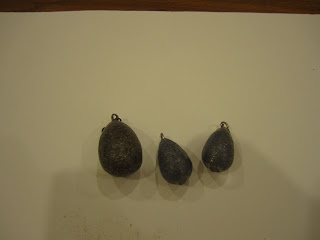Above are some gripper/method leads used for bolt rigs and also to aid in packing method, groundbait or packbait.
I am getting closer at finishing up some beginner how to videos. Todays video is all about carp fishing leads and what each type can do for you. This is a beginner video and I am hoping this will help any new carp anglers get into the sport faster while also learning the terminology behind each product, rig or bait I show in these videos.
The above are some different styles of distance leads. As the name states they are used for casting longer distance usually in excess of 100 yards.
The above lead as you can see has many little bumps on it. This lead is used for feature finding with a marker rod and marker float so you can determine the bottom contours and to see what type of bottom it is such as silt, sand, mud or rock.
Back Leads are used to pin down your line. The left set attaches on once you have already cast your lines and clips on near the rod tip and slides down the line. The second is a flying back lead and goes behind the lead and will fly back on the cast to help pin the line and not alert the fish and also aids in boats that cross over your lines.
My personal favorite is the inline cube. I use this for a bolt rig and because of the small size and heavy weight it will put more weight on the area creating a bolt rig that is hard to eject and has more penetrating power.
This lead has a swivel epoxied into the top and since it is natural if you have any other rocks like this in your lake it will blend in perfectly and will not alert the fish.
The Avid inline bag is used in pva bags. It has a small hole in the side for a pva nugget and you can bury your hook into that nugget so it allows the hook to not get tangled in the bag.
The method feeder is typically used for groundbait applications but you can use pack bait or method as well. The fish will crash against the weight freeing up the compress food and cause a feeding frenzy.
The pear is the most common type of lead used and also the cheapest to buy. The only disadvantage is they tend to roll some on the lake bottom.
The flat pear solves the rolling issue of the regular pear and turns this into a cost effective lead that holds bottom well.
The above lead is used when there is silt present. The design allows the lead to hover down and lay on top of the silt instead of being buried like most leads would do on the cast.
I hope you enjoyed this rundown of all the common styles of leads on the market and hopefully this will give you a better idea of which leads will fit your style of fishing..











No comments:
Post a Comment